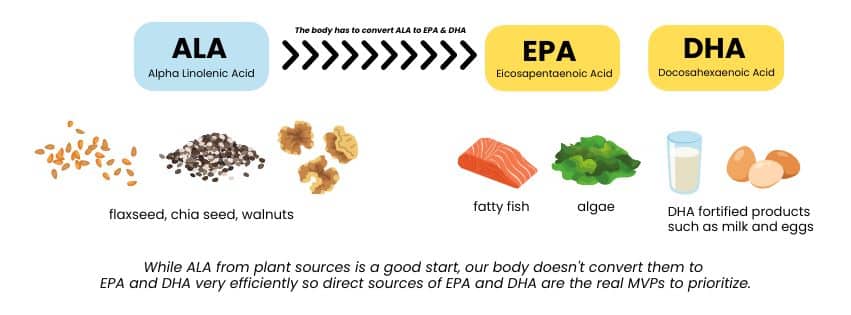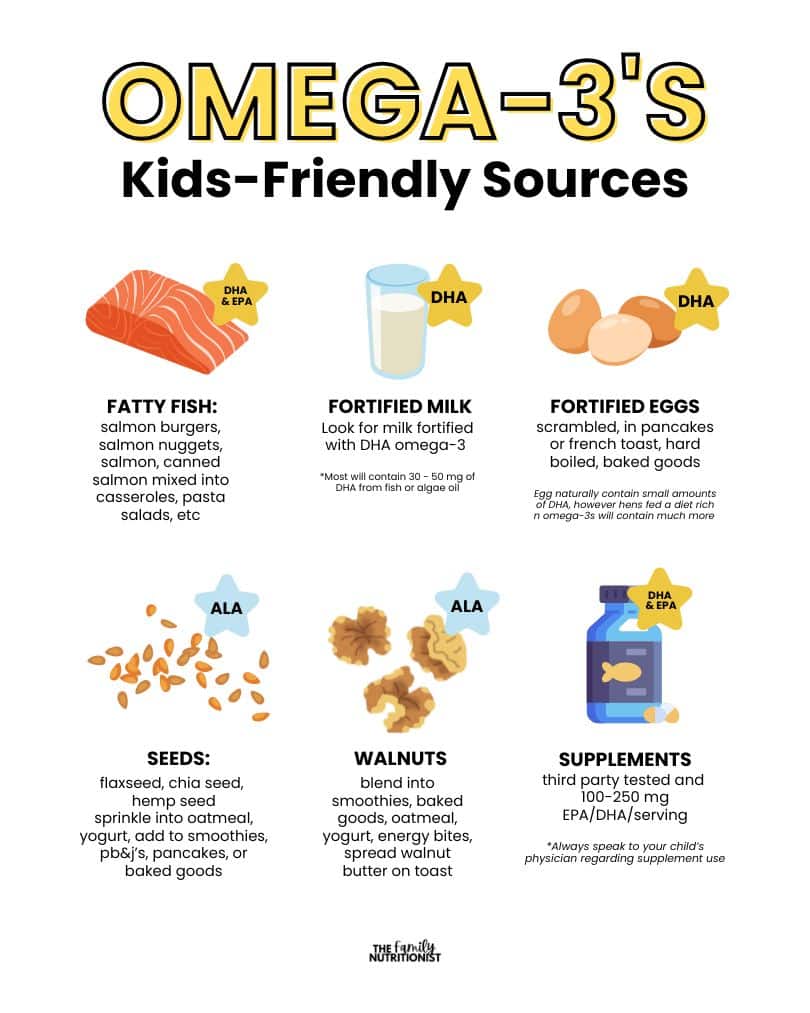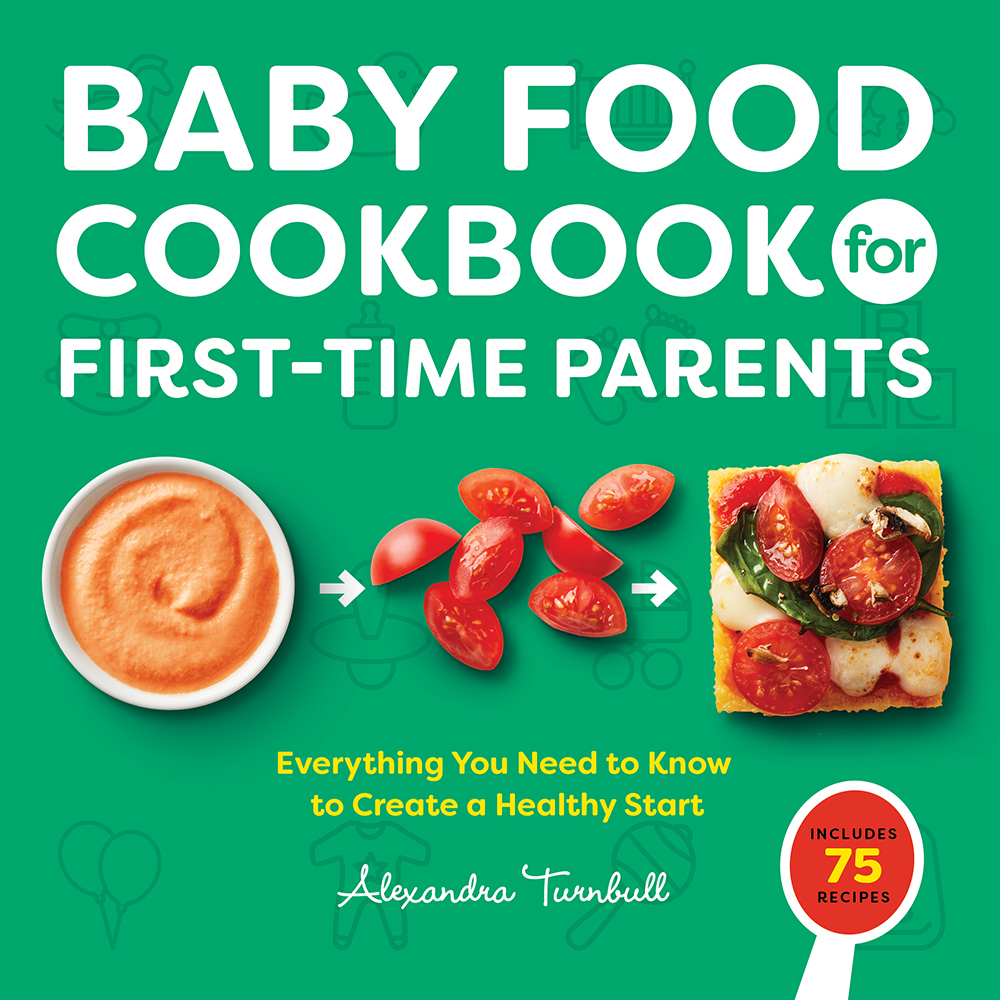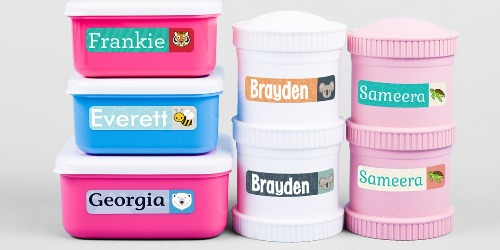Disclaimer: This blog post is for informational purposes only and is not intended to replace professional medical advice, diagnosis, or treatment. Always consult your child’s pediatrician or a registered dietitian before starting any new supplement or making significant changes to their diet. This post may contain affiliate links. Read our disclosure here.
If you’re a mom, you’ve probably heard that omega-3s are important for kids—but getting enough? That’s another story. Maybe your kid thinks fish is “too fishy” (despite the mountains of ketchup you offer). Maybe you’re raising a vegetarian or vegan family and wondering if walnuts and flaxseeds are enough. Or maybe you’ve heard omega-3s help with brain development, ADHD, and focus but don’t know where to start.
Let’s break down omega-3s for kids: how much they really need, why it’s important (especially for kids with ADHD), how to get it from food, and whether a supplement might be necessary.
Table of Contents
What Are Omega-3s, Anyway?
Omega-3s are a type of essential fatty acid, which means our bodies can’t make them on their own. We have to get them from food or supplements. They’re like the VIPs of the fat world, playing a key role in brain development, eye health, and even mood regulation. For kids, they’re especially important because little brains are growing at warp speed!
There are three main types of omega-3s:
- ALA (alpha-linolenic acid): Found in plant foods like flaxseeds, chia seeds, and walnuts.
- EPA (eicosapentaenoic acid): Found in fatty fish like salmon, mackerel, and sardines.
- DHA (docosahexaenoic acid): Also found in fatty fish and super important for brain and eye health.

ALA vs. EPA and DHA: What’s the Deal?
Here’s the thing: Not all omega-3s are created equal. ALA (the plant-based omega-3 found in flaxseeds, chia seeds, and walnuts) is great, but it’s not as powerful as EPA and DHA. Why? Because our bodies have to convert ALA into EPA and DHA, and unfortunately, that conversion process is pretty inefficient—only about 5-10% of ALA gets turned into EPA, and even less into DHA.
So, while ALA is still a good addition to your child’s diet, it’s not enough on its own. To really reap the benefits of omega-3s, we need to focus on EPA and DHA, which are found in fatty fish, supplements, and certain algae-based supplements.
Omega-3s for Kids: Why It’s A Big Deal
Omega-3s for kids, especially EPA and DHA, play several critical roles in health and development. Here’s a quick breakdown of how:
- Brain Development: DHA is a major structural component of the brain and supports cognitive function, memory, and learning.
- Eye Health: DHA is essential for the development of the retina and overall visual function.
- Behavior and Mood Regulation: may help reduce symptoms of ADHD and improve emotional regulation. However, the research is still mixed on this.
- Immune Support: contains anti-inflammatory properties that support a healthy immune system.
- Heart Health: supports healthy cholesterol levels and cardiovascular function, even in kids.
In short, omega-3s, particularly EPA and DHA, are like tiny superheroes for your child’s brain, eyes, heart, mood, and immune system. If your kiddo isn’t getting enough from food, a high-quality supplement might be worth considering (with your pediatrician’s okay, of course!).
Omega-3s and ADHD: What the Research Says
Several studies suggest that kids with ADHD tend to have lower levels of omega-3s compared to their peers. Researchers have looked at whether increasing omega-3 intake—through diet or supplements—could help with symptoms like impulsivity, attention, and hyperactivity.
Here’s what we know:
- Kids with ADHD tend to have lower omega-3 levels than their neurotypical peers.
- Higher DHA levels are linked to improved attention and working memory.
- EPA supplementation has been shown to help with impulsivity and emotional regulation
- A higher EPA-to-DHA ratio may be most effective for ADHD symptoms.
- Studies suggest a minimum of 750 mg/day or even higher.
- Effects aren’t instant. It can take several weeks to months to notice a difference.
- Omega-3s aren’t a replacement for ADHD medications (if your child is on them), but they may be a helpful add-on.
While omega-3s for kids aren’t a magic cure for ADHD, research suggests they can be a helpful piece of the puzzle for supporting focus, emotional regulation, and behavior. Learn more about the best nutrients to support ADHD here.
How Much Omega-3 Are Kids Getting?
Here’s the reality when it comes to omega-3s for kids: Most kids aren’t getting enough, especially EPA and DHA. In fact, 95% of Americans aren’t getting enough EPA and DHA so there’s definitely room for improvement across all ages.
This is partly because picky eating habits often exclude fish, and many families rely on processed foods that lack these essential fats. The good news? Even small changes, like adding a serving of salmon or a high-quality supplement, can make a big difference.
How Much Omega-3 Do Kids Need?
There’s no official daily recommendation for EPA and DHA for kids in the U.S., but here’s what the World Health Organization suggests:
- 2-6 years: 100-200 mg/day EPA + DHA
- 6 + years: 200-250 mg/day EPA + DHA
- For ADHD: Studies suggest >750 mg/day EPA + DHA may be beneficial.
Can Kids Have Too Much Omega-3’s?
Whenever there are supplements to consider, of course under the supervision of you or your child’s doctor, there’s usually a question about how much is too much.
When it comes to whether there’s a concern for too much Omega-3s for kids, the first thing to consider is that most are not getting enough so the likelihood of getting too much is small. However, both the FDA and the European Food Safety Authority (EFSA) claim that supplements with EPA and DHA are safe if they do not exceed 5,000mg – which far exceeds the typical doses in omega-3 supplements, especially for kids.
Speak with you or your child’s physician to discuss an appropriate dosage regarding an omega-3 supplement.
What About Vegetarian and Vegan Kids?
If your child follows a vegetarian or vegan diet, don’t worry—they can still get their omega-3s! While fatty fish is off the table, there are plenty of plant-based sources of ALA, like flaxseeds, chia seeds, hemp seeds, and walnuts. However, as mentioned earlier, ALA doesn’t convert well to EPA and DHA, so it’s important to ensure they’re getting enough of these active forms.
For vegan and vegetarian kids, algae-based supplements are a fantastic option. Algae is one of the few plant sources that naturally contains EPA and DHA, making it a great alternative to fish oil.
Vegan Omega-3s: flaxseed, chia seeds, hemp seeds, walnuts, and algae.
Vegetarian Omega-3s: all of the above plus fortified milk products
Easy Ways to Add More Omega-3s (Even for Picky Eaters!)

The American Heart Association recommends that kids eat 2 servings of fatty fish per week to meet their omega-3 needs – and let’s be honest, this probably isn’t happening in most households. One serving is about the size of their palm (or roughly 2-3 ounces, depending on their age).
If your kid eats salmon like it’s their job, congrats! But if you’re dealing with a kid who thinks anything from the ocean is “sus“, here are some easy ways to get more omega-3s into their diet:
For the Fish-Loving Kid (or the One Who Can Be Bribed with Ketchup):
An easy way to think of the best fish options for EPA and DHA omega-3s is to remember the acronym SMASH: Salmon, Mackerel, Anchovies, Sardines, Herring. Learn more about the levels of EPA and DHA in different fish here.
- Salmon fish sticks – Go ahead and let them dip in whatever they want!
- Salmon or tuna casserole – add canned salmon or tuna into pasta dishes
- Tuna or salmon melts – Melt cheese on it, and they might just eat it.
- Sardines on crackers – I know this sounds wild, but some kids love it!
For the Kid Who Won’t Eat Anything That Swims:
- Omega-3-enriched eggs – Scrambled, boiled, or in French toast.
- DHA-fortified milk – in smoothies, as a beverage, in cereal or oatmeal, in baked goods etc.
- Chia pudding – Mix chia seeds with milk and vanilla for a pudding that’s secretly full of ALA.
- Walnut butter on toast or in oatmeal – Creamier than peanut butter, and packed with omega-3s. More ideas for walnuts here.
- Tiny Sprouts Organic Milled Brain Boosters – sprinkle on yogurt, oatmeal, or toast, mix into smoothies or baked goods,
- Brainiac products – smoothie pouches, fruit snacks, applesauce
For the Smoothie-Lover:
- Chia or flax seeds in smoothies – Blend them up, and they’ll never know.
- Algal oil DHA drops – If fish oil isn’t an option, DHA from algae is a great plant-based alternative!
- Walnuts – use walnut butter or grind up walnuts to add to smoothies
- DHA-fortified milk – a great way to add a little more DHA
What to Look for in an Omega-3 Supplement
If your child isn’t eating a lot of omega-3-rich foods, a supplement might be a good idea, under the supervision of your child’s doctor of course. But not all omega-3 supplements are equal—some are loaded with sugar, low in actual DHA/EPA, or poor quality. At the end of the day, the best supplement for your child is the supplement they will actually tolerate.
Here’s what to check:
✔ DHA & EPA content – At least 100-250 mg of combined EPA & DHA per serving.
✔ Third-party testing – Look for IFOS, USP, or NSF certifications to make sure it’s free from heavy metals and contaminants.
✔ Minimal added sugars – Some gummies are basically candy with a sprinkle of fish oil. But if this is what your child tolerates, go with it!
✔ Algal oil for vegan/vegetarian kids – It’s one of the best plant-based DHA sources.
For information on what to look for read more here.
Recommended Brands with Third-Party Testing
Here are a few brands that have third-party testing to ensure safety and purity and also contain at least 100 mg or more of EPA and DHA content per serving:
- Nordic Naturals Children’s DHA – soft gels, chewable, liquid, vegetarian
- Barlean’s Omega Pals – liquid
- Garden of Life Kids – liquid
- Carlson Kids Fish Oil – liquid
- OmegaVia Kids Omega-3 – chewable
- Nature’s Craft Omega 3 + DHA – drops
Always consult your child’s pediatrician or a registered dietitian before starting any new supplement or making significant changes to their diet.
The Bottom Line
Omega-3s for kids are a nutrient powerhouse, supporting everything from brain development to immune health. However, most individuals aren’t getting enough.
While ALA from plant sources is a good start, our body doesn’t convert them to EPA and DHA very efficiently so direct sources of EPA and DHA are the real MVPs to prioritize. Salmon, mackerel, anchovies, sardines, and herring are some of the best sources of EPA and DHA. Sources of ALA include walnuts, chia, and flaxseeds.
The best approach is food first, but a high-quality supplement can help fill the gaps – and always speak with their pediatrician or dietitian regarding supplementation.
So whether your kid is munching on sardines (bless them), sipping a DHA-boosted smoothie, or popping a supplement, getting in those omega-3s is worth it.
And remember, you’re doing an amazing job—even if it feels like your child’s diet consists of 90% carbs and 10% stubbornness.





